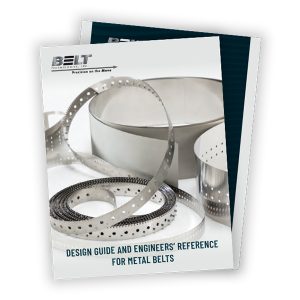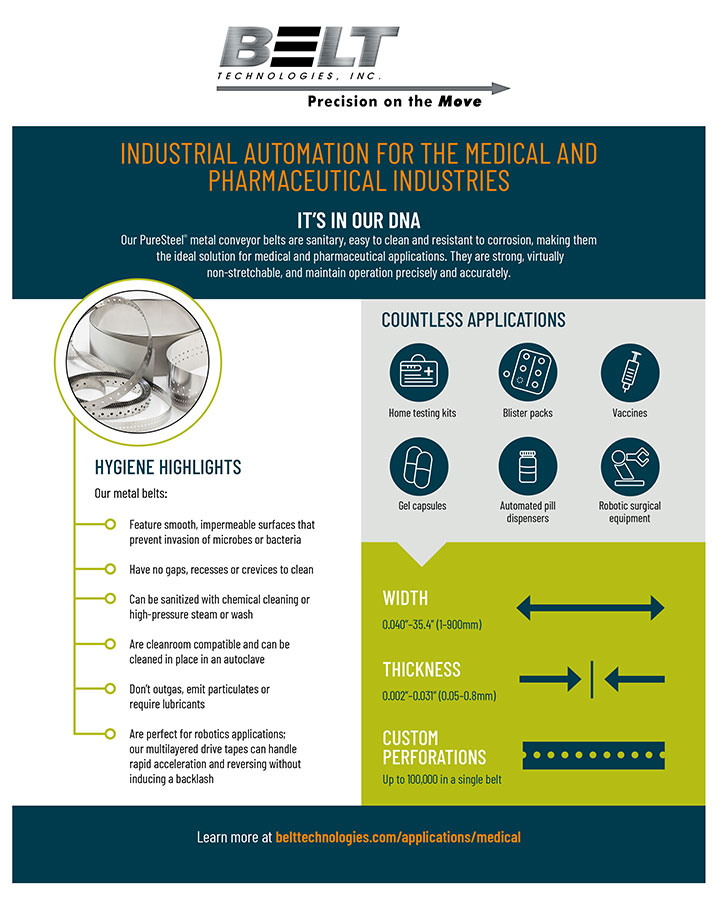Belt tracking is accomplished by increasing or decreasing the tension on one edge of the belt in relation to the other edge. It is a process similar to tensioning the belt during installation. If the tension on one side of the belt is too high, the belt will begin tracking off the pulley toward the side with lower tension. Adjustments can be made to increase or decrease tension and stabilize the belt. Ignoring these tracking issues will shorten the overall lifespan of the belt, cause inaccurate product placement, and ultimately result in product damage.
What Causes Conveyor Belt Tracking Issues?
Stainless steel conveyor belts are virtually non-stretchable and will not yield under tension, which can make tracking more difficult. The belt cannot naturally flex to compensate for factors that will gradually draw the belt off track. Tracking issues are typically caused by:
- Poor system alignment
- Uncontrolled pulley shaft deflection
- Differential loading
- Belt camber (edge bow, or the deviation of a belt edge from a straight line)
Every type of conveyor belt has some camber. Stainless steel belts typically have a camber of less than 0.050” (1.27 mm) in 8’ (2.44 mm). In any squared, two-pulley system, one edge of the belt will be tensioned more than its counterpart because it has a shorter edge circumference. This variation will inevitably cause the belt to track away from the tighter edge when the belt is rotated. The primary objective of any tracking technique is to prevent or counteract the accumulative negative tracking stresses.
Methods to Resolve or Prevent Belt Tracking Problems
Belt Technologies has a variety of strategies available to counteract negative tracking stresses and keep your metal conveyor belt system in alignment.
Manual Pulley Axis Adjustment
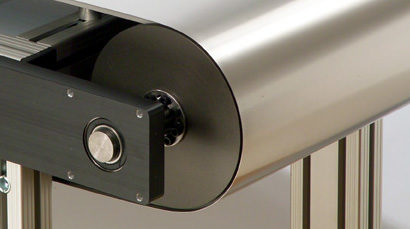
Pulleys can be manually adjusted to compensate for tracking issues.
For most metal conveyor belt systems, manual adjustment of the pulley axes is an effective way to compensate for tracking issues. Belt edge tensions are adjusted in a controlled manner to steer the belt into an aligned position on the pulley. The technique can be used with both flat-faced and crowned-faced pulleys, though Belt Technologies does not recommend using crowned-faced pulleys in any metal conveyor belt systems.
Ideally, both the drive and idler pulleys will have adjustable axes for precise adjustments. However, typically only the idler pulley will feature adjustable axes, because the drive pulley usually interfaces with motors and other power transmission devices, making it more difficult to adjust.
Forced Tracking
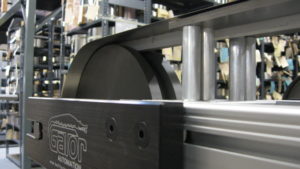
V-guided tracking is a reliable means of forced tracking for metal conveyor belts.
For some systems, a simple pulley axis adjustment may not be enough to completely eliminate or prevent improper tracking. Belt Technologies engineers can provide design feedback on the best strategy for achieving proper tracking in existing systems, such as installing cam followers or glass-filled Teflon® flanges. Forced tracking techniques can potentially shorten the expected life of a belt, but our experts can adjust the system in various ways—such as using a thicker conveyor belt—to mitigate these effects.
Wider metal conveyor belts can be installed with a V-belt bonded to the inner circumference of the belt. V-guides are part of the Belt Technologies Metrak© system and help distribute tracking stresses on the V-guide rather than on the belt itself. In a forced tracking system, V-guides help maximize belt lifespan.
Independent Steerable Pulley (ISP)
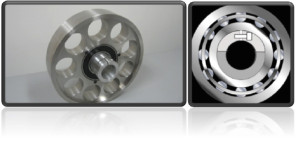
Belt Technologies developed the Independent Steerable Pulley to make tracking adjustments easier.
The independent steerable pulley, or ISP, is an innovative concept designed and engineered by Belt Technologies. It can be used in two-pulley conveyor systems, systems with multiple idler pulleys on a common shaft, or systems with serpentine or complex belt paths. The ISP changes the tension relationships across the width of the belt by adjusting the angle of the pulley in relation to the belt.
Rather than moving the pulley shaft with a pillow-block adjustment, the ISP fits a steering collar and sealed bearing assembly to the body of the pulley. When rotated, the steering collar changes the angle of the pulley body, resulting in controlled, bidirectional movement of the belt across the pulley face. The ISP provides a simple method of steering flat metal belts and is exclusively available from Belt Technologies.
Our engineers can design and build custom conveyor systems with preventative tracking measures to address the requirements of your specific system. They can also provide troubleshooting and support for existing systems that are experiencing tracking issues. To learn more about tracking solutions for stainless steel metal belts, contact the experts at Belt Technologies today.


